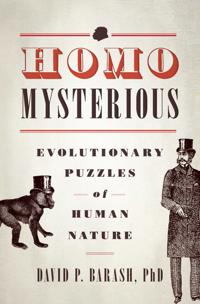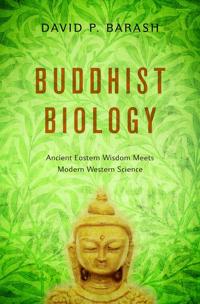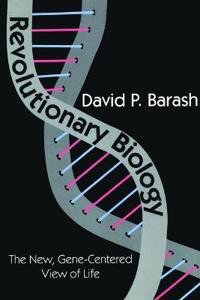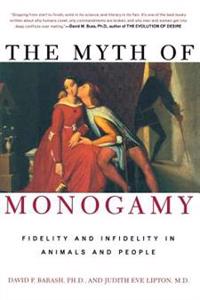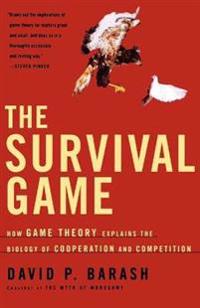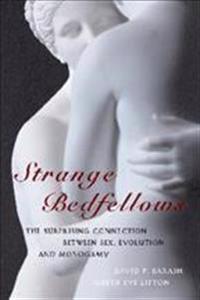Peace and Conflict Studies (Häftad)
avDavid P. Barash, Charles P. Webel
ISBN: 9781412961202 - UTGIVEN: 200809This core textbook comprehensively introduces students to the relatively young interdisciplinary field of peace and conflict studies. Five years after the text's original publication, it is time for an update that reflects changes on the world scene, as well as the need to add new material and expan[...]
Peace and Conflict Studies (Häftad)
avDavid P. Barash, Charles P. Webel
ISBN: 9781452202952 - UTGIVEN: 201305Peace and Conflict Studies Third Edition, sets the standard for an accessible introduction and comprehensive exploration of this vital subject. The authors share their vast knowledge and analysis of 21st-century world events u including new chapters on research methodsaandademocracy, as well as time[...]
Homo Mysterious (Inbunden)
avDavid P. Barash
ISBN: 9780199751945 - UTGIVEN: 201206For all that science knows about the living world, there are even more things that we don't know, genuine evolutionary mysteries that perplex the best minds in biology. And paradoxically, many of these mysteries are very close to home: They involve some of the most personal aspects of being human, [...]
Approaches to Peace: A Reader in Peace Studies (Häftad)
avDavid P. Barash
ISBN: 9780199949151 - UTGIVEN: 201307Approaches to Peace: A Reader in Peace Studies, Third Edition, provides a unique and interdisciplinary sampling of key articles and literary selections focusing on the diverse facets of peace and conflict studies. Featuring both classic and contemporary work, it enables students to read highly influ[...]
Buddhist Biology (Inbunden)
avDavid P. Barash
ISBN: 9780199985562 - UTGIVEN: 2014-02An eye-opening look at the crossroads of religion and science, illuminating the unexpected common ground shared by biology and Buddhism. Many high-profile public intellectuals-such as the well-known "New Atheists" Richard Dawkins, Daniel Dennett, and the late Christopher Hitchens-have argued that r[...]
How Women Got Their Curves and Other Just-So Stories: Evolutionary Enigmas (Övrig)
avJudith Eve Lipton, David P. Barash
ISBN: 9780231146647 - UTGIVEN: 2009-04-10So how did women get their curves? Why do they have breasts, while other mammals only develop breast tissue while lactating, and why do women menstruate, when virtually no other beings do so? What are the reasons for female orgasm? Why are human females kept in the dark about their own time of ovul[...]
How Women Got Their Curves and Other Just-So Stories: Evolutionary Enigmas (Övrig)
avMD Judith Eve Cor, David P. Barash
ISBN: 9780231146654 - UTGIVEN: 2010-01-14So how did women get their curves? Why do they have breasts, while other mammals only develop breast tissue while lactating, and why do women menstruate, when virtually no other beings do so? What are the reasons for female orgasm? Why are human females kept in the dark about their own time of ovul[...]
Revolutionary Biology (Pocket)
avDavid P. Barash
ISBN: 9780765809636 - UTGIVEN: 2003-03There is a revolution underway in biology. It is based on a new perception of bodies and genes, in which the former are the end product of the latter within the continuum of evolution. Twenty fi ve years after Richard Dawkins helped revolutionize our thinking about "selfi sh genes," it is time to re[...]
The Myth of Monogamy: Fidelity and Infidelity in Animals and People (Häftad)
avDavid P. Barash, Judith Eve Lipton
ISBN: 9780805071368 - UTGIVEN: 200205Applying new research to sex in the animal world, esteemed scientists David P. Barash and Judith Eve Lipton dispel the notion that monogamy comes naturally. In fact, as The Myth of Monogamy reveals, biologists have discovered that for nearly every species, cheating is the rule — for both sexes.[...]
The Survival Game: How Game Theory Explains the Biology of Cooperation and Competition (Häftad)
avDavid P. Barash
ISBN: 9780805076998 - UTGIVEN: 2004-09Humans, like bacteria, woodchucks, chimpanzees, and other animals, compete or cooperate in order to get food, shelter, territory, and other resources to survive. But how do they decide whether to muscle out or team up with the competition? In The Survival Game, David P. Barash synthesizes the newest[...]
Strange Bedfellows: The Surprising Connection Between Sex, Evolution and Monogamy (Inbunden)
avDavid P. Barash, Judith Eve Lipton
ISBN: 9781934137208 - UTGIVEN: 2009-10In "The Myth of Monogamy," husband and wife David P. Barash (an evolutionary biologist) and Judith Eve Lipton (a psychiatrist), stunned the public by showing how rare monogamy is in nature. Now, in "Strange Bedfellows," they look at the other side of the coin: how biology actually promotes monogamy [...]
Wie die Frauen Zu Ihren Kurven Kamen: Die Ratselhafte Evolutionsbiologie Des Weiblichen (Inbunden)
avDavid P. Barash, Judith Eve Lipton
ISBN: 9783827424617 - UTGIVEN: 2010-04Ja, wie sind denn die Frauen zu ihren Kurven gekommen? Warum haben sie Bruste, wahrend andere Saugetiere nur dann Brustgewebe ausbilden, wenn sie Milch geben, und warum menstruieren Frauen, wahrend fast alle anderen Geschopfe darauf verzichten? Welche Grunde gibt es fur den weiblichen Orgasmus? Wies[...]



